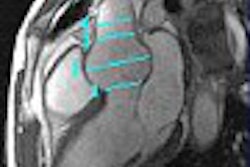Imaging departments today face immense financial pressures from insufficient staffing. Adopting ultrasound ergonomics policies that target prevention of work-related musculoskeletal injuries can prove invaluable, not just in improving staff morale, but in achieving bottom-line gains.
Any time there is insufficient staff to perform studies, a department’s reimbursement revenue potential is directly impacted. And solutions to the staffing dilemma are not always economic or efficient.
In addition, temporary staffing or frequent staff turnover often present concerns for the multiple skill and technical requirements necessary for replacement staff. Maintaining a stable, skilled workforce saves time, energy, and effort.
Research shows that 84% of clinical sonographers experience pain related to their profession, and 20% suffer career-ending injuries. Workers’ compensation costs employers across all industries $15 billion-$20 billion a year in direct costs, and four to six times that in indirect costs.
Workforce shortages are affecting productivity, patient care, and reimbursement revenue. As an administrator, the best way to manage work-related musculoskeletal injury in sonography is to prevent it.
Work safety
Much information has been presented in recent years on methods for reducing risk of injury and implementing workplace safety. Studies have shown that effective ergonomics programs can significantly reduce the risk for occupational injury across all professions.
However, a recent study on the work status of all employees who filed claims for musculoskeletal disorders (MSDs) discovered that 65% of claimants return to work after filing a claim, but without any ergonomics improvements to the work environment. This oversight misses an ideal opportunity to retain valuable staff by failing to employ simple ergonomics changes and training.
The best scenario is to retain the employee at work or bring about an early return through a combination of task restructuring, light work development (such as performing alternate duties or receiving a temporary reduction in workload or in specific duties performed), ergonomics interventions, and/or assistive technology.
Keeping the staff you can’t afford to lose
So what about the employee who has already sustained a work-related injury? What can be done to salvage their career and maintain the proven level of competency that the staff member offers to the department? How does the management of an injured employee affect the morale of the group as a whole?
Seasoned, highly skilled sonographers bring efficiency and effective patient management to the department. The relationship established between a sonographer and a radiologist is unique in its dependence on each other’s expertise.
By allowing the sonographer more autonomy and trusting their expertise, the radiologist is able to process patient load more proficiently. This level of confidence could not exist with new staff or frequent staff turnover.
Allied health professionals make up 60% of the healthcare work force. While recent growth in patient volumes in diagnostic imaging has been significant, the level of available staff has unfortunately not increased at a comparable rate.
Consequently, most imaging departments are chronically short-staffed, especially in ultrasound. A study conducted in 2000 by Dallas-based management firm U.S. Radiology Partners (USRP) found that 42% of hospital-based imaging departments were understaffed in ultrasound sonographer positions.
In addition to affecting quality of care, staffing shortages also impact the financial viability of hospitals. USRP noted that the imaging department is one of the few profitable areas in most hospitals. Increased demand for imaging services is hard to achieve when the imaging department is already understaffed.
Another study commissioned by the American Hospital Association, the Association of American Medical Colleges, the Federation of American Hospitals, and the National Association of Public Hospitals and Health Systems found that the shortage of healthcare workers was significant in the U.S., with imaging technicians experiencing the greatest vacancy rate. The study also found that hospitals have been having increasing difficulty filling imaging staff positions since 1999, with increasing recruitment costs and financial impact.
Effective management of injured sonographers
Awareness and sensitivity by management is just important as education. Management must be aware of issues that may affect staff and be sensitive to their condition. This includes co-worker understanding and support, job satisfaction, workload and control perceptions, and supervisor approachability.
Be prepared to offer reasonable accommodations for the injury. Keeping highly skilled and efficiently trained staff is ultimately a cost-saving measure, both in terms of productivity and bottom-line finances. Generally, interventions relating to work schedule, adaptive equipment and modified duties are considered reasonable, assuming the employee can perform the essential functions of the job or is on track to return to their original job duties.
Repetitive-strain injuries cost industries $100 billion a year in lost work time. In the medical field alone, it is estimated that ergonomically related injuries account for as many as 70% of all hospital injuries. One of the greatest costs from workers’ comp comes from paying total temporary wage loss; being able to return an injured worker back to work under their managing physician’s guidance goes a long way in reducing that expense.
Basic phases of ergonomics intervention should be considered. These include:
- Work analysis
- Problem evaluation
- Proposal of solutions
- Implementation of solutions
- Evaluation of results
Closely monitor complaints of work-related illnesses or conditions. Be open to discussion with your staff regarding their concerns. This goes a long way to supporting staff morale and cooperative solutions to work safety issues. Be sure to document all incidents and complaints, as well as responses to incidents and complaints, including employee’s disability status, ability to perform job tasks, and requests for accommodations and outcome of solutions.
Management success
Successful management of work-related injury directly influences staff absenteeism, turnover, morale, and productivity. Recent research shows that in addition to physical risk factors associated with musculoskeletal injuries (MSIs), there are psychosocial risk factors.
These psychosocial factors include retaining a sense of control over work (which can be affected by imposed pacing), open communication, and support from co-workers and supervisors. As a result, both physical and psychosocial factors should be considered in implementing ergonomics programs. Best practices or excellence in management considers all aspects of the employee’s job.
The goal is to provide training to reduce the risk for injury below the hazard level or to the degree technologically and economically feasible. This involves both employee and administrative involvement. Making work safety attainable and openly involving staff in the process is an important aspect to the success of the program.
Be aware that products themselves are not ergonomics. It's the relationship between the user, the task, and the equipment that will achieve successful intervention. All ultrasound professionals and management personnel should be educated about the scope and risk factors of sonographer work-related injury.
Regular in-house training and orientation of existing and new personnel should be performed. Department policy should include a work-safety program specific to the issues related to sonographer work-related musculoskeletal disorder (WRMSD). Training workers how to identify high-risk activities, recognize the signs and symptoms of injury, and participate in developing solutions offers value-added benefits, in addition to reducing worker injuries.
Some managers prefer to designate an ergonomics delegate within the department. This person serves as a resource for information and modifications, as well as a contact point for employees with concerns or ideas for improvement. Involving the entire staff in the process can be a very good team-building activity. The ergonomics delegate also acts as a liaison and resource for administrators.
Conclusion
A proactive effort to address ergonomics in sonography is an important aspect of any department policy. Ergonomics programs are an absolute necessity, but how programs are used makes or breaks a successful ergonomics process.
The solution may not necessarily be found in the actual written ergonomics program, but in its application, implementation, and incorporation. Ergonomics should be a tangible item on the fiscal budget, as an integral part of the overall management strategy.
This helps eliminate the mindset that ergonomics are separate from budgetary influences as just part of "the cost of doing business;" instead, it creates the awareness that ergonomics is an initiative that clearly impacts the bottom-line success of the department. As a result, ergonomics can be used as a competitive advantage, not only to retain employees, but attract new staff as well.
By Susan L. MurpheyAuntMinnie.com contributing writer
March 26, 2004
Susan L. Murphey is director of operations at Sound Ergonomics, a consulting firm specializing in ergonomics for allied health professionals.
Suggested Reading
http://www.soundergonomics.com/
http://www.soundergonomics.com/Pages/Admin_Risk/econ_of_ergonomics.htm
www.sdms.org/pdf/wrmsd2003.pdf
www.osha.gov/SLTC/ertonomics/index.html
Related Reading
Work-related musculoskeletal injuries continue to plague rads, August 20, 2003
Sonography society publishes ergonomics standards, June 19, 2003
Small investments in imaging ergonomics yield major gains, May 21, 2003
No more spaghetti: A recipe for improving utilization and throughput, November 7, 2002
A multimedia guide to ergonomics sonographer positioning, September 18, 2002
Copyright © 2004 Sound Ergonomics



















